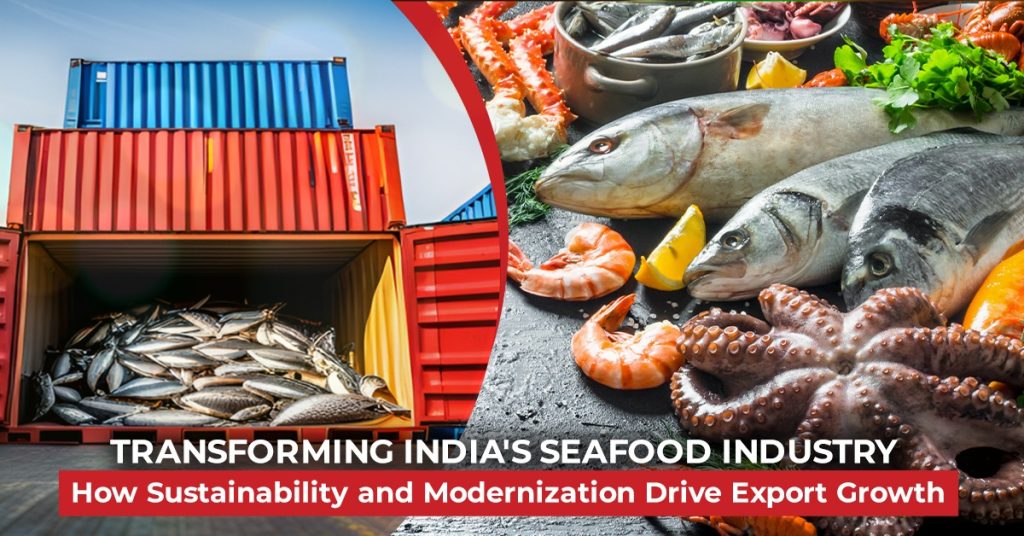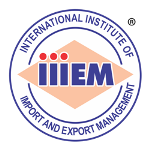Seafood Industry – Boosting India’s Export Potential

India stands on the verge of a transformative opportunity in its seafood industry. The country’s advantageous position in the seafood market is due to its geographical location. With a coastline stretching over 7,500 kilometers, India has access to a range of resources. From reefs filled with exotic fish to deep ocean areas housing commercially valuable species, the waters surrounding India support a rich biodiversity that fuels its thriving seafood industry.
India is currently one of the top five global exporters in the seafood industry.
Going ahead, the Indian seafood industry aims for greater achievements by setting a target of reaching US$ 13.2 billion (Rs. 1 trillion) in exports. To accomplish this goal, India relies on its workforce with expertise in both traditional and modern fishing practices, sets up quality standards for sea food when reaching global markets.
Export performance
India’s seafood exports hit all-time high in FY 2022-23, grow 26.73% in quantity & 4.31% in value.
In FY23, India’s seafood exports hit a record high, reaching 17,35,286 metric tones (MT) valued at US$ 8,094.31 million (Rs. 63,969.14 crore). The US remained the primary importer of Indian seafood, with a share of 33.52%. Meanwhile, exports to China, the second-largest market destination, stood at 18.64%. Additionally, the European Union, Southeast Asia, Japan, and the Middle East also emerged as key markets for Indian seafood.

Aquaculture
Aquaculture, which involves the cultivation of fish, shrimp, algae, or shellfish, serves as a crucial factor for India’s fishing industry, driving its economic prosperity. Each farm receives a unique identification number after verification, including GPS coordinates.
These farms are linked to the Pre-Harvest Test and National Residue Control Plan to monitor banned antibiotics. In 2022–23, 1,501 new farms were enrolled, and 2,683 farms underwent level two verification. Currently, out of the 78,779 enrolled farms, 56,083 farms covering 99,617 hectares have been approved after level two verification.
Strategies to boost export potential
India has set an ambitious target of reaching Rs. 1 trillion (US$ 11.99 billion) in the coming years. Here, we explore key strategies that can help India achieve this goal:
- Sustainable Practices
The future of the seafood industry hinges on sustainable practices. India can lead by example through the adoption of fishing techniques that have no impact on the environment. This involves enforcing regulations to avoid unethical fishing and utilizing gear that reduces unintended catches. By placing an emphasis on sustainability, India can secure a lasting supply of resources and appeal to eco conscious consumers globally.
- Modernization
Technology can help propel India’s seafood industry to greater heights with the help of technology. Enhancing fishing vessels with innovative tools will improve efficiency and increase safety while out at sea. It will also elevate the overall standards of the industry. One of the most critical aspects is upgrading the cold chain infrastructure, establishing a network of refrigerated transport and storage facilities to reduce spoilage and maintain product quality along the supply chain. These investments are essential for securing long-term profitability and a reputation for excellence.
- Value Addition and Branding
The seafood sector in India has the potential to boost its worth by moving beyond exporting raw materials. Transforming seafood into enhanced products such as meals or pre-seasoned fillets aligns with the changing consumer tastes and will help fetch better prices. Building brands that appeal to consumers will add more value to Indian seafood. Strategic marketing efforts that highlight the freshness, excellence and distinctive tastes of seafood can help penetrate new markets and establish brand loyalty.
- International Standards
Ensuring that seafood exports meet quality and safety requirements is essential. By establishing quality checks and earning certifications such as Hazard Analysis and Critical Control Points (HACCP), India can highlight its dedication to delivering nutritious and safe seafood products. This helps establish credibility with buyers and creates opportunities to access new markets with rigorous standards.
- Emerging Markets
In addition to focusing on the established markets, it is worthwhile to consider the potential of emerging markets such as Southeast Asia and Africa. These regions are witnessing an increase in demand for seafood, presenting India with a chance to leverage its proximity and competitive pricing to emerge as a favored provider.
In conclusion, reaching the goal of establishing a Rs. 1 trillion (US$ 11.99 billion) seafood industry requires a systematic approach. Embracing sustainable practices is not only ethically right but also offers a competitive edge.
Upgrading fishing vessels and infrastructure will enhance efficiency and help meet quality benchmarks.
Emphasizing on value addition and strategic branding can enhance the reputation of Indian seafood worldwide.
Exploring growing emerging markets presents promising avenues for growth. However, achieving this vision calls for action.
The government is playing a supportive role by offering assistance through policies, subsidies, and trade deals.
The seafood industry in India offers immense potential for growth, particularly in exports, with a target of Rs. 1 trillion (US$ 13.2 billion) in exports. This sector benefits from India’s extensive coastline of over 7,500 km, which supports a wealth of marine resources and diverse fishing practices. Ranked among the top global seafood exporters, India leverages both traditional and advanced fishing methods along with a skilled workforce to meet international demand.
If you’re interested in tapping into this booming industry, www.iiiem.in/import-and-export-management. is an excellent opportunity to gain the necessary skills. This comprehensive program is tailored for aspiring entrepreneurs and professionals, covering crucial areas like market strategies, export-import policies, documentation, and much more. Hands-on sessions with industry experts provide practical knowledge, setting you on the right path to succeed in global trade.
